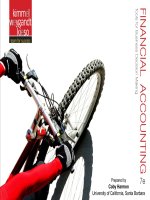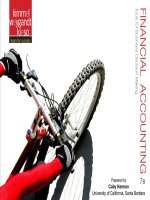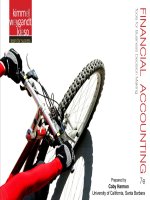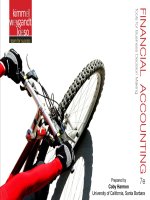Financial accounting tools for business decision making 9 KIeso ppt ch04
Bạn đang xem bản rút gọn của tài liệu. Xem và tải ngay bản đầy đủ của tài liệu tại đây (760.16 KB, 91 trang )
Financial Accounting
Ninth Edition
Kimmel Weygandt Kieso
Chapter 4
Accrual Accounting Concepts
Prepared by
Coby Harmon
University of California, Santa Barbara
Westmont College
Chapter Outline
Learning Objectives
LO 1
Explain the accrual basis of accounting and the reasons for adjusting entries.
LO 2
Prepare adjusting entries for deferrals.
LO 3
Prepare adjusting entries for accruals.
LO 4
Prepare an adjusted trial balance and closing entries.
Copyright ©2019 John Wiley & Son, Inc.
2
Learning Objective 1
Explain the Accrual Basis of
Accounting and the Reasons for
Adjusting Entries
LO 1
Copyright ©2019 John Wiley & Sons, Inc.
3
Periodicity Assumption
Accountants divide the economic life of a business into artificial time periods generally a month, quarter,
or year.
.....
Jan.
•
Apr.
Prepared by most large companies
Dec.
HELPFUL HINT
An accounting time period
that is one year long is
Reporting periods can be
•
LO 1
Mar.
Quarterly and annual financial statements
•
•
Feb.
called a fiscal year.
Calendar year from January 1 to December 31
Copyright ©2019 John Wiley & Son, Inc.
4
Accrual-Basis and Periodicity
What is the periodicity assumption?
a.
Companies should recognize revenue in the accounting period in which services are
performed.
LO 1
b.
Companies should match expenses with revenues.
c.
The economic life of a business can be divided into artificial time periods.
d.
The fiscal year should correspond with the calendar year.
Copyright ©2019 John Wiley & Son, Inc.
5
Accrual-Basis and Revenue Recognition
Revenue Recognition Principle
Revenue Recognition
Recognize revenue in the
Satisfied
accounting period in which the performance obligation is
performance
satisfied.
obligation
Customer
Cash
requests
received
service
Revenue should be recognized in the accounting
period in which the service is performed.
LO 1
Copyright ©2019 John Wiley & Son, Inc.
6
Revenue Recognition
Step 1: Identify the contract
A contract is an agreement between two parties that creates enforceable rights or
with customers.
obligations. Sierra has a contract with the Lewis family to provide guide services.
Step 2: Identify the separate
Sierra has only one performance obligation—to provide guide services. If Sierra also agreed
performance obligations in
to sell the customer camping equipment, a separate performance obligation is recorded for
the contract.
this promise.
The transaction price is the amount of consideration that a company expects to receive
Step 3: Determine the transaction price.
from a customer in exchange for transferring a good or service. The transaction price for
Sierra is $1,500.
Step 4: Allocate the transaction price to the separate
performance obligations.
Sierra has only one performance obligation—to provide guide services to the Lewis family.
Step 5: Recognize revenue when each performance
Sierra recognizes revenue of $1,500 for providing guide services to the Lewis family when it
obligation is satisfied.
satisfies its performance obligation—the completion of the guide trip.
LO 1
Copyright ©2019 John Wiley & Son, Inc.
7
Accrual-Basis and Expense Recognition
Expense Recognition Principle
Companies recognize expenses in the period in which they make
Expense Recognition
efforts (consume assets or incur liabilities) to generate revenue.
Matching
Revenues
Delivery
“Let the expenses follow the
revenues.”
Advertising
Utilities
Expenses
LO 1
Copyright ©2019 John Wiley & Son, Inc.
8
Revenue and Expense Recognition
GAAP Relationships
Periodicity Assumption
Economic life of business can be divided into artificial time
periods.
Revenue Recognition
Expense Recognition
Principle
Principle
Recognize revenue in the
Recognize expenses with revenues in the period when the
accounting period in which the
company makes efforts to generate those revenues.
performance obligation is satisfied.
Revenue and Expense Recognition
In accordance with generally
accepted accounting principles
(GAAP).
LO 1
Copyright ©2019 John Wiley & Son, Inc.
9
Accrual-Basis of Accounting
Which of the following statements about the accrual basis of accounting is false?
a.
Events that change a company’s financial statements are recorded in the periods in which the
events occur.
b.
Revenue is recognized in the period in which services are performed.
c.
This basis is in accordance with generally accepted accounting principles.
d.
Revenue is recorded only when cash is received, and expense is recorded only when cash is
paid.
LO 1
Copyright ©2019 John Wiley & Son, Inc.
10
Accrual versus Cash Basis Accounting (1 of 2)
Accrual-Basis Accounting
•
Transactions recorded in the periods in which the events occur
•
Companies recognize revenues when they perform services rather than when they receive
cash
LO 1
•
Expenses are recognized when incurred rather than when paid
•
In accordance with generally accepted accounting principles (GAAP)
Copyright ©2019 John Wiley & Son, Inc.
11
Accrual- versus Cash Basis Accounting (2 of 2)
Cash-Basis Accounting
•
Revenues recognized when cash is received
•
Expenses recognized when cash is paid
•
Cash-basis accounting is not in accordance with generally accepted accounting principles
(GAAP)
LO 1
Copyright ©2019 John Wiley & Son, Inc.
12
Comparing Accrual- versus Cash Basis
2021
Activity
2022
Purchased paint, painted
building, paid employees
Accrual
basis
Revenue
$80,000
Revenue
$0
Expense
50,000
Expense
0
Net income
Cash
basis
LO 1
Received payment for work done in 2021
$30,000
Net Income
$0
Revenue
$0
Revenue
$80,000
Expense
50,000
Expense
0
Net loss
$(50,000)
Copyright ©2019 John Wiley & Son, Inc.
Net income
$80,000
13
Need for Adjusting Entries
LO 1
•
To ensure that the revenue recognition and expense recognition principles are followed
•
Necessary because the trial balance may not contain up-to-date and complete data
•
Required every time a company prepares financial statements
•
Will include one income statement account and one balance sheet account
Copyright ©2019 John Wiley & Son, Inc.
14
The Need for Adjusting Entries
Adjusting entries are made to ensure that
a.
expenses are recognized in the period in which they are incurred.
b.
revenues are recorded in the period in which services are performed.
c.
balance sheet and income statement accounts have correct balances at the end of an
accounting period.
d.
LO 1
All the responses above are correct.
Copyright ©2019 John Wiley & Son, Inc.
15
Categories of Adjusting Entries
Deferrals
Accruals
1.
1.
Prepaid Expenses. Expenses paid in cash before
they are used or consumed.
Accrued Revenues. Revenues for services
performed but not yet received in cash or
recorded.
2. Unearned Revenues.
2.
Cash received before services are performed.
LO 1
Accrued Expenses. Expenses incurred but not yet
paid in cash or recorded.
Copyright ©2019 John Wiley & Son, Inc.
16
Trial Balance
Sierra Corporation
Trial Balance
October 31, 2022
Debit
Subsequent examples are
Cash
based on this trial balance
Supplies
from Chapter 3.
Credit
$15,200
2,500
Prepaid Insurance
600
Equipment
5,000
Notes Payable
$ 5,000
Accounts Payable
2,500
Unearned Service Revenue
1,200
Common Stock
10,000
Retained Earnings
0
Dividends
500
Service Revenue
10,000
Salaries and Wages Expense
LO 1
Rent Expense
4,000
Copyright ©2019 John Wiley & Son, Inc.
900
17
DO IT! 1 Timing Concepts
Below is a list of timing concepts in the left column, with
a description of the concept in the right column. There
are more descriptions provided than concepts. Match
the description to the concept
(a)
Monthly and quarterly time periods.
(b)
Efforts (expenses) should be matched with results (revenues).
(c)
Accountants divide the economic life of a business into artificial time
periods.
(d)
Companies record revenues when they receive cash and record
expenses when they pay out cash.
1. ___ fAccrual-basis accounting.
2. ___e
3. ___
4. ___
LO 1
c
b
(e)
An accounting time period that starts on January 1 and ends on
December 31.
Calendar year.
Periodicity assumption.
(f)
Companies record transactions in the period in which the events
occur.
Expense recognition principle.
Copyright ©2019 John Wiley & Son, Inc.
18
Learning Objective 2
Prepare Adjusting Entries for Deferrals
LO 2
Copyright ©2019 John Wiley & Sons, Inc.
19
Adjusting Entries for Deferrals
Deferrals are costs or revenues that are recognized at a date later than the point when cash was
originally exchanged
Types of deferrals:
•
•
Prepaid expenses
Unearned revenues
Analyze
Adjusted Trial
Balance
LO 2
Journalize
Trial Balance
Post
Financial Statements
Closing Entries
Copyright ©2019 John Wiley & Son, Inc.
Journalize and Post
AJEs
Post-Closing Trial Balance
20
Prepaid Expenses
Payments of expenses that are recorded as an asset to show the service or benefit the company will
receive in the future.
Cash Payment
BEFORE
Expense Recorded
Prepayments often occur in regard to
LO 2
•
insurance
•
rent
•
supplies
•
equipment
•
advertising
•
buildings
Copyright ©2019 John Wiley & Son, Inc.
21
Prepaid Expenses
•
Expire either with the passage of time or through use
•
Adjusting entry
.
Increase (debit) to an expense account and
.
Decrease (credit) to an asset account
Asset
LO 2
Expense
Unadjusted
Credit
Debit
Balance
Adjusting Entry (-)
Adjusting Entry (+)
Copyright ©2019 John Wiley & Son, Inc.
22
Supplies
Illustration: Sierra Corporation purchased supplies costing $2,500 on October 5. Sierra recorded the
payment by increasing (debiting) the asset Supplies. This account shows a balance of $2,500 in the
October 31 trial balance. An inventory count at the close of business on October 31 reveals that $1,000 of
supplies are still on hand.
Oct. 31 Supplies Expense
LO 2
Supplies
(To record supplies used)
Copyright ©2019 John Wiley & Son, Inc.
1,500
1,500
23
Adjustment for Supplies
Basic
The expense Supplies Expense is increased $1,500; the asset Supplies is decreased $1,500.
Analysis
Equation
Analysis
(1)
Debit-Credit
Assets
=
Liabilities
+
Stockholders’ Equity
Supplies
=
Supplies Expense
-$1,500
=
-$1,500
Debits increase expenses: debit Supplies Expense $1,500.
Analysis
Credits decrease assets: credit Supplies $1,500.
Oct. 31
Supplies Expense
Journal
1,500
Supplies
Entry
1,500
(To record supplies used)
Supplies
Supplies Expense
Posting
to
Oct. 5
2,500
Oct. 31
Adj. 1,500
Oct. 31
Adj. 1,500
Oct. 31
Bal. 1,500
Ledger
Oct. 31
LO 2
Bal. 1,000
Copyright ©2019 John Wiley & Son, Inc.
24
Insurance
Illustration: On October 4, Sierra Corporation paid $600 for a one-year fire insurance policy. Coverage
began on October 1. Sierra recorded the payment by increasing (debiting) Prepaid Insurance. This
account shows a balance of $600 in the October 31 trial balance. Insurance of $50 ($600 ÷ 12) expires
each month.
Oct. 31 Insurance Expense
LO 2
Prepaid Insurance
(To record expired insurance)
Copyright ©2019 John Wiley & Son, Inc.
50
50
25









